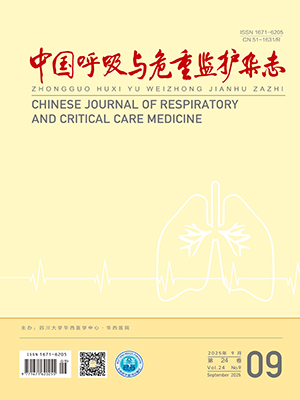【Abstract】 Objective To investigate the clinical characteristics and prognosis of secondary lymphocytic interstitial pneumonia ( LIP) . Methods Clinical data of 9 cases with secondary LIP diagnosed from1990 to 2010 were retrospectively analyzed. Results Of 9 patients there were 3 males and 6 females,the range of age was 7-64 years. In the 6 adult patients there were 5 females. 2 cases were infected by EB virus and 1 by recurrent pulmonary infection in 3 non-adult patients. In the adult patients, 1 case was diagnosed with Sjogren’s syndrome, 1 case with overlapping syndrome, 2 cases with primary biliary cirrhosis,1 case was probably caused by infection, and 1 case was complicated with eosinophilia. Dominant symptoms of pulmonary system were cough, expectoration, and shortness of breath on exertion. Dominant systematic symptoms were asthenia, pyrexia, weight lose, and arthralgia. CT revealed diffuse ground glass opacities with a lower lung zone predominance. Pathologic feature of LIP was a diffuse, polyclonal lymphoid cell infiltration surrounding airways and extending to the lung interstitium. The patients were treated by glucocorticoid and immunosuppressants. Two cases died with secondary infection. Follow-up did not comfirm malignant tumors in the survivors. Conclusions The clinical features of LIP are characteristic, but lacking of specificity. The final diagnosis depends on pathological examination. Treatment targeted on primary diseases can probably have a good efficacy, and the clinical outcome is favorable.
Citation: LU Zhiwei,HUANG Hui,ZHANG Jian,ZHU Yuanjue,XU Zuojun.. Clinical Features and Prognosis of Secondary Lymphocytic Interstitial Pneumonia: An Analysis of Nine Cases. Chinese Journal of Respiratory and Critical Care Medicine, 2011, 10(1): 72-76. doi: Copy
Copyright © the editorial department of Chinese Journal of Respiratory and Critical Care Medicine of West China Medical Publisher. All rights reserved




